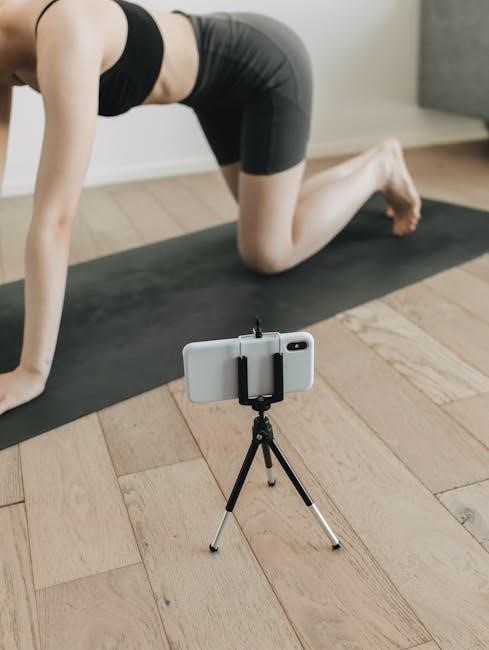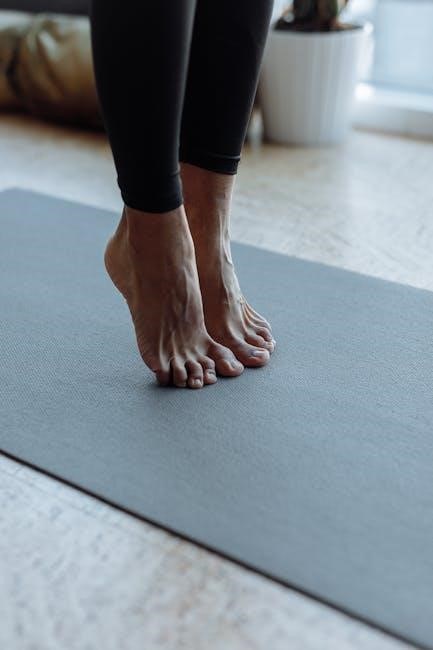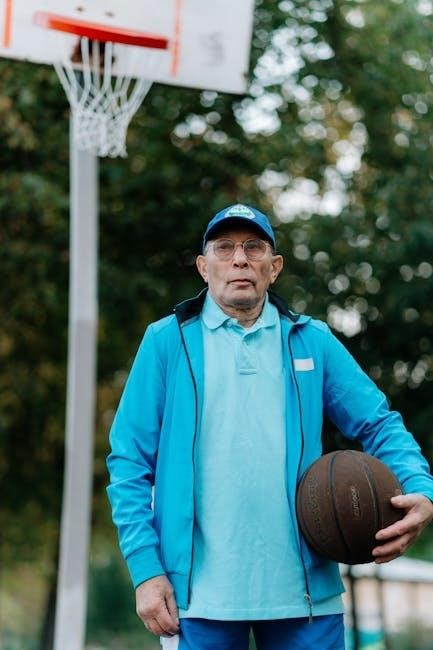
Exploring the evolving role of yoga teachers in modern practice, this section introduces the fundamentals of yoga instruction, adapting to diverse student needs and digital advancements.
1.1 Understanding the Role of Yoga Teachers in Modern Practice
Modern yoga teachers play a pivotal role in fostering physical, mental, and emotional well-being. Their responsibilities extend beyond instructing poses, encompassing creating safe spaces, personalizing practices, and building communities. With the rise of digital platforms, teachers now adapt to online formats, ensuring accessibility and inclusivity. Empathy and cultural sensitivity are crucial, as they cater to diverse backgrounds and needs. Effective teachers also prioritize hands-on adjustments with consent, promoting trust and comfort. By staying updated with yoga research and trends, they continuously evolve their teaching methods. Ultimately, the role of a yoga teacher is to empower students, helping them connect with their bodies and minds while fostering a sense of belonging and growth.
1.2 The Evolution of Yoga Instruction in the Digital Age

The digital age has transformed yoga instruction, making it more accessible and versatile. With the rise of online platforms, teachers now offer virtual classes, workshops, and training programs, reaching a global audience. Apps and websites provide on-demand content, allowing students to practice at their convenience. Social media has become a powerful tool for teachers to share tips, inspire followers, and build communities. The COVID-19 pandemic accelerated this shift, proving that yoga can thrive in a virtual format. Despite the challenges of maintaining intimacy and hands-on adjustments online, innovative solutions like Zoom classes and pre-recorded sessions have emerged. This evolution ensures that yoga remains relevant and adaptable, bridging gaps between tradition and modern technology to foster growth and well-being worldwide.

Key Qualities of Effective Yoga Teachers
Effective yoga teachers embody empathy, adaptability, and a deep understanding of student needs, fostering connection and growth through personalized instruction and compassionate guidance.
2.1 The Importance of Empathy and Personalization in Teaching
Empathy and personalization are crucial in yoga instruction, allowing teachers to tailor practices to individual needs and foster deeper connections. By understanding each student’s unique journey, teachers create a supportive environment that encourages growth and well-being. This approach ensures that students feel seen and valued, enhancing their overall experience and progress in yoga. Personalization also helps address physical limitations and mental health challenges, making the practice more accessible and beneficial for everyone. Through empathy, teachers build trust and rapport, which are essential for a transformative yoga journey.
2.2 Building a Community: The Role of Connection in Yoga Classes
Building a community in yoga classes fosters a sense of belonging and connection among students. Teachers play a vital role in creating this environment by encouraging interaction and mutual support. Shared experiences, group discussions, and inclusive practices help break down barriers, making students feel part of a collective journey. Connection strengthens commitment and motivation, as students inspire and uplift one another. A strong community also provides emotional support, enhancing the overall well-being of its members. By nurturing these relationships, teachers not only deepen their students’ practice but also create a lasting impact beyond the mat.

Instructional Strategies for Yoga Teachers
Effective yoga teachers employ diverse instructional strategies, including hands-on adjustments, adaptive techniques, and clear communication, to foster a supportive and inclusive learning environment for all students.
3.1 Hands-On Adjustments: Best Practices and Consent
Hands-on adjustments are a powerful tool in yoga instruction, enhancing alignment and deepening poses. However, consent is crucial. Teachers should always ask before touching, respecting students’ boundaries. Clear communication ensures a safe and comfortable environment. Instructors must be trained in proper techniques to avoid injuries. Additionally, offering verbal cues as an alternative allows students to maintain autonomy. Creating a culture of consent fosters trust and respect, making the practice more enjoyable and beneficial for everyone involved. Regular feedback from students can help refine adjustment approaches, ensuring they meet individual needs while upholding professional standards.
3.2 Adapting Instruction for Diverse Student Needs and Levels
Effective yoga teachers recognize the importance of tailoring instruction to meet the unique needs of each student. This involves offering modifications for poses, accommodating different skill levels, and addressing physical limitations. Teachers should encourage open communication to understand students’ goals and challenges; Incorporating props, such as blocks or straps, can help make poses more accessible. Additionally, creating an inclusive environment by honoring diverse backgrounds and abilities fosters a sense of belonging. By adapting instruction, teachers ensure that every student, regardless of experience or capability, can benefit from the practice. This personalized approach not only enhances learning but also builds a supportive and engaging classroom atmosphere.
3.3 The Power of Visualization and Verbal Cues in Teaching
Visualization and verbal cues are powerful tools yoga teachers use to guide students effectively. By painting vivid mental images, teachers help students connect with their practice on a deeper level. Verbal cues provide clear direction, enhancing focus and alignment. For example, guiding students to “imagine a string pulling the crown of the head upward” can improve posture. These techniques also accommodate diverse learning styles, making instruction more inclusive. Teachers can adapt cues to suit varying levels of experience, ensuring everyone feels supported. The combination of visualization and verbal guidance fosters a more engaging and transformative practice, allowing students to explore their full potential safely and mindfully.

Creating a Safe and Inclusive Learning Environment
Fostering a safe and inclusive space is essential for effective yoga instruction, ensuring students feel respected, supported, and comfortable throughout their practice.
4.1 Setting Boundaries and Encouraging Student Comfort
Setting clear boundaries is crucial for creating a safe yoga environment. Teachers should establish guidelines for communication, physical adjustments, and class etiquette to ensure student comfort. Encouraging open dialogue about personal space and preferences helps build trust; Instructors should also be mindful of power dynamics and avoid actions that may make students feel vulnerable. By fostering a respectful and inclusive atmosphere, teachers empower students to focus on their practice without distractions. This approach not only enhances the learning experience but also promotes a sense of community and mutual respect within the class.
4.2 Cultural Sensitivity and Respect in Yoga Instruction
Cultural sensitivity is essential in yoga instruction to honor its roots and respect diverse student backgrounds. Teachers should avoid cultural appropriation by understanding the significance of practices and traditions. Using Sanskrit terms correctly and sharing their meanings fosters appreciation. Instructors should also adapt practices to suit modern, multicultural settings while preserving their essence. Encouraging inclusivity by respecting students’ cultural and personal identities creates a welcoming environment. This approach ensures that yoga remains a unifying practice that respects its heritage while embracing diversity. By being mindful of cultural nuances, teachers can promote a deeper understanding and connection to yoga’s philosophy.

The Business of Yoga Instruction
Effective marketing, branding, and strategic planning are crucial for yoga teachers to build a successful business, ensuring sustainable growth and professional visibility.
5.1 Marketing Your Yoga Teaching Business Effectively
Effective marketing is vital for yoga teachers to attract students and build a loyal community. Start by identifying your unique selling points, such as specialized styles or personalized instruction. Leverage social media platforms like Instagram and Facebook to share engaging content, including class highlights, testimonials, and wellness tips. A professional website showcasing your schedule, philosophy, and contact information is also essential. Consider collaborating with local studios, wellness centers, or influencers to expand your reach. Offer free introductory sessions or workshops to draw new students. Consistent branding and regular communication through newsletters or blog posts can help maintain visibility and trust. By combining online and offline strategies, you can create a strong, recognizable brand that resonates with your target audience.
5.2 Timing Your Yoga Teacher Training (YTT) Launch
Timing the launch of your Yoga Teacher Training (YTT) program is crucial for its success. Consider market demand and the needs of aspiring teachers. Launching during periods of high interest, such as the start of a new year or post-summer, can attract motivated students. Analyze competitors’ programs to identify gaps your YTT can fill. Ensure your curriculum is well-prepared and aligned with industry standards. Promote your program in advance to build anticipation and secure enrollments. A well-timed launch can maximize visibility and attract a dedicated group of students eager to embark on their teaching journey.

The Future of Yoga Instruction
The future of yoga instruction is evolving with technology, offering virtual classes and AI-driven personalized sessions, enhancing global accessibility and inclusivity for diverse practitioners.
6.1 Emerging Trends in Yoga Teaching and Practice
Emerging trends in yoga include virtual and hybrid classes, AI-driven personalized sessions, and integrative approaches blending mindfulness with modern wellness practices. These innovations enhance accessibility and cater to diverse needs, ensuring yoga remains relevant in a rapidly changing world. Additionally, there is a growing emphasis on cultural sensitivity and inclusivity, encouraging teachers to adapt traditional practices to resonate with contemporary lifestyles and diverse student backgrounds. Such trends not only expand the reach of yoga but also deepen its impact on mental and physical well-being.

6.2 The Role of Technology in Modern Yoga Instruction
Technology has revolutionized yoga instruction, offering new ways to teach and practice. Virtual and hybrid classes enable global accessibility, while AI-driven tools provide personalized feedback and adaptive learning. Apps and online platforms allow students to practice at home, track progress, and connect with teachers remotely. Additionally, technology facilitates community building through virtual workshops, forums, and social media groups; These advancements not only expand the reach of yoga but also enhance the learning experience, making it more interactive and tailored to individual needs. However, balancing tech integration with the human touch remains crucial to preserve the holistic essence of yoga.

Continuous Education for Yoga Teachers
Continuous education is vital for yoga teachers to refine skills, adapt to new trends, and deepen their understanding of yoga’s evolving practices and philosophies.
7.1 The Importance of Ongoing Learning and Certification
Ongoing learning and certification are essential for yoga teachers to stay updated with the latest techniques and research. Continuous education ensures they can address diverse student needs effectively, while maintaining high standards of teaching. Certification programs provide structured pathways for professional growth, allowing teachers to specialize in various yoga styles or therapeutic approaches. By committing to lifelong learning, yoga instructors not only enhance their expertise but also foster a culture of excellence and innovation in their practice. This dedication to education ultimately benefits both the teacher and their students, creating a more dynamic and inclusive learning environment.
7.2 Staying Updated with the Latest Yoga Research and Techniques
Staying current with the latest yoga research and techniques is crucial for effective instruction. Emerging studies highlight yoga’s benefits for mental and physical health, while new techniques enhance class variety and student engagement. Attending workshops, seminars, and online courses helps teachers incorporate evidence-based practices. Following industry leaders and subscribing to yoga journals provide insights into innovative approaches. By staying informed, teachers can address diverse student needs, improve class dynamics, and contribute to the evolution of yoga. Continuous updates ensure their teaching remains relevant and impactful, fostering a safe and transformative environment for all practitioners.

The Impact of Yoga on Mental and Physical Health
Yoga significantly improves both mental and physical well-being, reducing stress and anxiety while enhancing flexibility, strength, and overall health through mindful practice and breathwork techniques.
8.1 How Yoga Teachers Can Promote Mental Well-being
Yoga teachers play a vital role in fostering mental well-being by creating a safe, inclusive environment that encourages mindfulness and relaxation. Through guided breathwork, meditation, and thoughtful sequencing, instructors can help students reduce stress and anxiety. Personalized instruction allows teachers to address individual needs, ensuring practices are tailored to promote emotional balance. Verbal cues and positive affirmations can enhance self-awareness and confidence, while hands-on adjustments, when consented, provide physical and mental relief. By emphasizing the mind-body connection, teachers empower students to cultivate resilience and calm, making yoga a powerful tool for mental health. This holistic approach fosters long-term well-being, enabling students to navigate life’s challenges with greater ease and clarity.
8.2 The Role of Yoga in Addressing Physical Health Challenges
Yoga serves as a versatile tool for addressing physical health challenges by enhancing flexibility, strength, and balance. Through tailored postures and breathing techniques, yoga can aid in rehabilitation and pain management, offering relief for conditions like chronic back pain and arthritis. Teachers can adapt practices to suit individual limitations, ensuring accessibility for all levels. Regular practice improves circulation, reduces inflammation, and supports immune function. Additionally, yoga’s focus on alignment and body awareness helps prevent injuries and improves overall physical stability. By integrating these elements, yoga teachers contribute to students’ long-term physical well-being, making it a complementary approach to traditional therapies for various health concerns.






